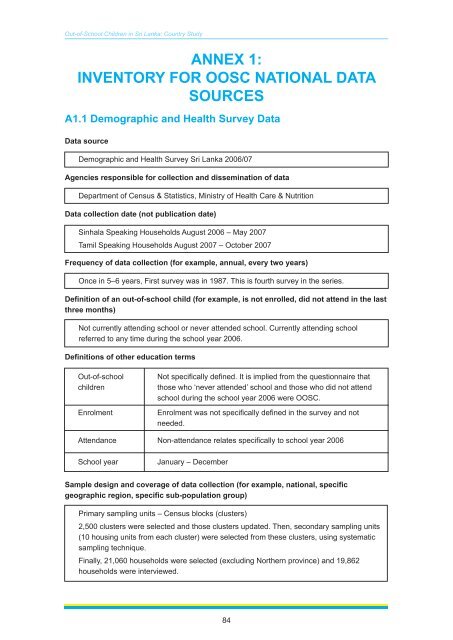Sri Lanka - Institut de statistique de l'Unesco
Sri Lanka - Institut de statistique de l'Unesco
Sri Lanka - Institut de statistique de l'Unesco
You also want an ePaper? Increase the reach of your titles
YUMPU automatically turns print PDFs into web optimized ePapers that Google loves.
Out-of-School Children in <strong>Sri</strong> <strong>Lanka</strong>: Country Study<br />
ANNEX 1:<br />
INVENTORY FOR OOSC NATIONAL DATA<br />
SOURCES<br />
A1.1 Demographic and Health Survey Data<br />
Data source<br />
Demographic and Health Survey <strong>Sri</strong> <strong>Lanka</strong> 2006/07<br />
Agencies responsible for collection and dissemination of data<br />
Department of Census & Statistics, Ministry of Health Care & Nutrition<br />
Data collection date (not publication date)<br />
Sinhala Speaking Households August 2006 – May 2007<br />
Tamil Speaking Households August 2007 – October 2007<br />
Frequency of data collection (for example, annual, every two years)<br />
Once in 5–6 years, First survey was in 1987. This is fourth survey in the series.<br />
Definition of an out-of-school child (for example, is not enrolled, did not attend in the last<br />
three months)<br />
Not currently attending school or never atten<strong>de</strong>d school. Currently attending school<br />
referred to any time during the school year 2006.<br />
Definitions of other education terms<br />
Out-of-school<br />
children<br />
Enrolment<br />
Attendance<br />
School year<br />
Not specifically <strong>de</strong>fined. It is implied from the questionnaire that<br />
those who ‘never atten<strong>de</strong>d’ school and those who did not attend<br />
school during the school year 2006 were OOSC.<br />
Enrolment was not specifically <strong>de</strong>fined in the survey and not<br />
nee<strong>de</strong>d.<br />
Non-attendance relates specifically to school year 2006<br />
January – December<br />
Sample <strong>de</strong>sign and coverage of data collection (for example, national, specific<br />
geographic region, specific sub-population group)<br />
Primary sampling units – Census blocks (clusters)<br />
2,500 clusters were selected and those clusters updated. Then, secondary sampling units<br />
(10 housing units from each cluster) were selected from these clusters, using systematic<br />
sampling technique.<br />
Finally, 21,060 households were selected (excluding Northern province) and 19,862<br />
households were interviewed.<br />
84

















